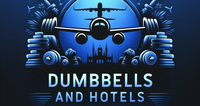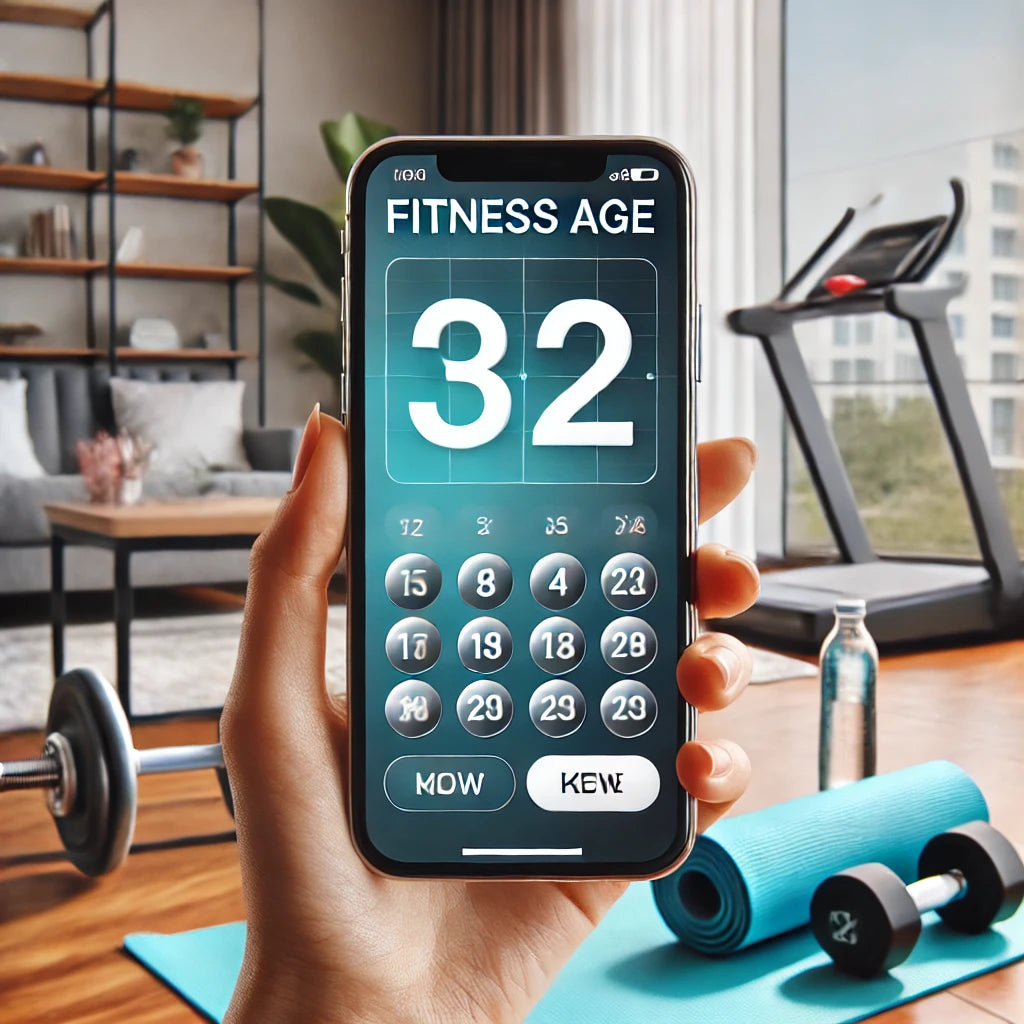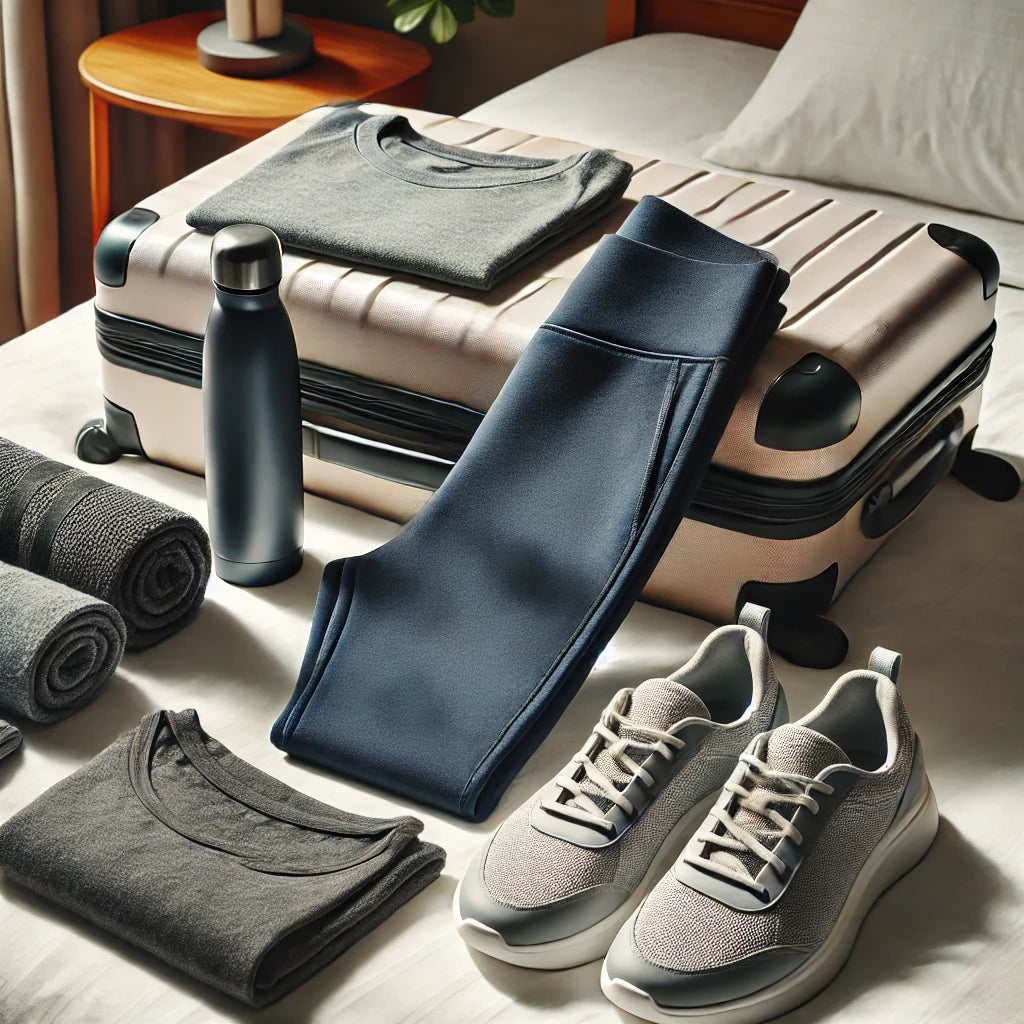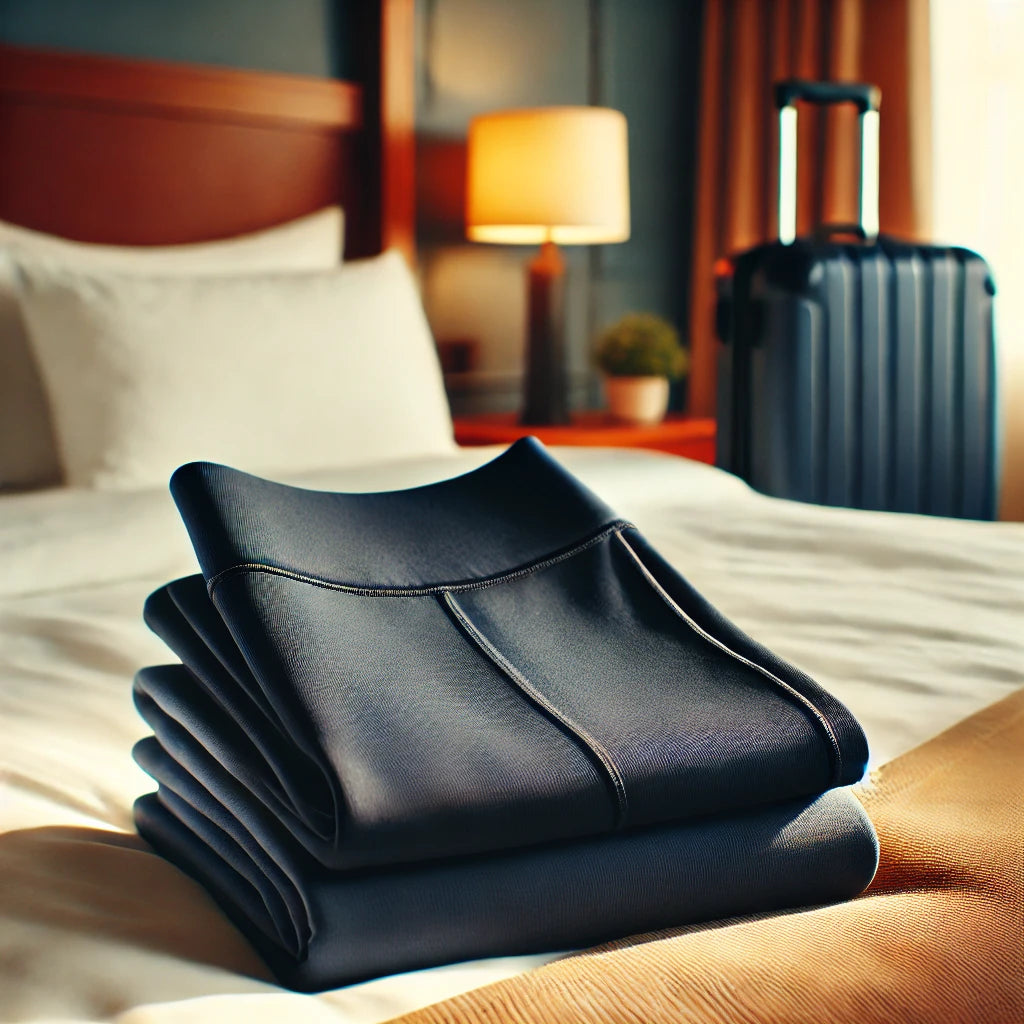Staying fit and healthy is crucial for a long and vibrant life, especially for traveling professionals like pilots, flight attendants, and travel nurses who face unique challenges in maintaining a consistent workout routine. The Fitness Age Calculator is an innovative tool designed to assess your fitness level, providing insights that go beyond chronological age. By understanding your fitness age, you can set personalized goals, optimize your workouts, and track your progress more effectively. This blog post will explore how the Fitness Age Calculator works, its benefits, and how it can help you achieve and maintain peak physical condition, no matter where your travels take you.

What is a Fitness Age Calculator?
A Fitness Age Calculator is a tool that measures various aspects of your physical health and fitness to determine an equivalent "fitness age." This concept goes beyond your actual age to reflect how well your body performs compared to others in different age groups. Factors considered include cardiovascular endurance, muscle strength, flexibility, and body composition.
Key Metrics of a Fitness Age Calculator
- Cardiovascular Endurance: Assesses how efficiently your heart and lungs work during exercise.
- Muscle Strength: Measures the strength and endurance of your muscles.
- Flexibility: Evaluates the range of motion in your joints.
- Body Composition: Looks at the ratio of fat to lean mass in your body.
How the Fitness Age Calculator Works
The Fitness Age Calculator uses various tests and measurements to provide an accurate assessment of your fitness level. Here are the primary components and how they are evaluated:
Cardiovascular Endurance
To measure cardiovascular endurance, the calculator might use a test like the VO2 max test, which measures the maximum amount of oxygen your body can use during intense exercise. This test is often conducted on a treadmill or stationary bike, where the intensity increases gradually while measuring your oxygen intake and carbon dioxide output.
Muscle Strength
Muscle strength is typically assessed using resistance exercises such as push-ups, pull-ups, or weight lifting. The number of repetitions or the maximum weight you can lift in one attempt (known as the one-rep max) helps gauge your muscle strength.
Flexibility
Flexibility tests, such as the sit-and-reach test, measure how flexible your muscles and joints are. This test involves sitting on the floor with your legs straight and reaching forward to touch your toes or beyond.
Body Composition
Body composition can be measured using methods like bioelectrical impedance analysis (BIA), skinfold measurements, or dual-energy X-ray absorptiometry (DEXA). These methods assess the proportion of fat to lean muscle in your body.
Benefits of Knowing Your Fitness Age
Understanding your fitness age offers several advantages, especially for those with demanding travel schedules:
- Personalized Fitness Goals: Knowing your fitness age allows you to set realistic and attainable fitness goals tailored to your current fitness level.
- Motivation: Seeing your fitness age decrease as you improve can be highly motivating, encouraging you to maintain or increase your workout intensity.
- Improved Health: By focusing on improving your fitness age, you can enhance your overall health, reduce the risk of chronic diseases, and increase your longevity.
- Informed Decisions: With a clear understanding of your fitness level, you can make informed decisions about your exercise routines, diet, and lifestyle choices.
Setting Goals Based on Your Fitness Age
Setting achievable goals is crucial for staying motivated and making consistent progress. Here’s how you can use your fitness age to set effective fitness goals:
Short-Term Goals
- Improve Cardiovascular Health: Aim to improve your VO2 max by incorporating more aerobic exercises, such as running, cycling, or swimming, into your routine.
- Increase Strength: Set specific targets for increasing the number of repetitions or the weight you lift in strength-training exercises.
- Enhance Flexibility: Incorporate daily stretching routines or yoga sessions to improve your flexibility.
Long-Term Goals
- Reduce Body Fat: Aim to lower your body fat percentage through a combination of diet and exercise, focusing on both cardio and strength training.
- Achieve a Lower Fitness Age: Set a goal to decrease your fitness age by a certain number of years over a set period, such as six months or a year.
- Sustain Healthy Habits: Develop and maintain healthy habits that contribute to overall fitness, such as regular exercise, balanced nutrition, adequate sleep, and stress management.
Fitness Strategies for Traveling Professionals
For traveling professionals, maintaining a consistent fitness routine can be challenging. However, with some strategic planning and adaptability, it is entirely possible. Here are some tips and strategies:
Plan Ahead
- Research Facilities: Before you travel, research the fitness facilities available at your destination, including hotel gyms, local gyms, parks, and running trails.
- Pack Smart: Bring essential fitness gear such as resistance bands, a jump rope, and portable workout clothes.
Adapt Your Workouts
- Hotel Room Workouts: Utilize bodyweight exercises that require no equipment, such as push-ups, squats, lunges, and planks.
- Gym Workouts: If your hotel has a gym, make the most of the available equipment to vary your routine and challenge different muscle groups.
Stay Active on the Go
- Incorporate Movement: Look for opportunities to stay active throughout your day, such as taking the stairs instead of the elevator or walking during phone calls.
- Stretch and Move: During long flights or drives, take breaks to stretch and move around to prevent stiffness and improve circulation.
Sample Workouts for Traveling Professionals
Here are some sample workouts that can be easily incorporated into your travel schedule, regardless of where you are:
Quick Hotel Room Workout
Warm-Up (5 minutes):
- Jumping jacks
- High knees
- Arm circles
Main Workout (20 minutes):
- Push-Ups: 3 sets of 15 reps
- Bodyweight Squats: 3 sets of 20 reps
- Plank: 3 sets of 1 minute
- Lunges: 3 sets of 15 reps per leg
- Tricep Dips (using a chair): 3 sets of 15 reps
Cool Down (5 minutes):
- Stretching (focus on all major muscle groups)
Quick Gym Workout
Warm-Up (5 minutes):
- Treadmill walking or jogging
- Dynamic stretches
Main Workout (30 minutes):
- Treadmill Intervals: 10 minutes (1 minute sprint, 1 minute walk)
- Dumbbell Bench Press: 3 sets of 12 reps
- Leg Press Machine: 3 sets of 15 reps
- Lat Pulldowns: 3 sets of 12 reps
- Cable Machine Tricep Pushdowns: 3 sets of 15 reps
Cool Down (5 minutes):
- Treadmill walking
- Stretching (focus on all major muscle groups)
![]()
Nutrition Tips for Optimizing Your Fitness
Nutrition plays a crucial role in maintaining and improving your fitness age. Here are some tips to help you stay on track with your diet, even when traveling:
Hydration
- Drink Water: Ensure you drink plenty of water throughout the day to stay hydrated, especially before, during, and after workouts.
- Limit Sugary Drinks: Avoid sugary drinks and opt for water, herbal teas, or electrolyte-rich beverages.
Balanced Diet
- Macronutrients: Aim for a balanced intake of macronutrients—proteins, carbohydrates, and fats—to fuel your body and support muscle recovery.
- Micronutrients: Incorporate a variety of fruits and vegetables into your diet to ensure you get essential vitamins and minerals.
Healthy Snacks
- Nutritious Choices: Pack healthy snacks like nuts, seeds, fruits, and protein bars to avoid unhealthy airport or convenience store options.
- Portion Control: Be mindful of portion sizes to avoid overeating, especially during long travel days.
Monitoring Your Progress
Tracking your progress is essential to stay motivated and make necessary adjustments to your fitness routine. Here are some methods to monitor your fitness journey:
Fitness Apps and Wearables
- Track Workouts: Use fitness apps like MyFitnessPal, Strava, or Nike Training Club to log your workouts and monitor your progress.
- Monitor Activity: Wearables like Fitbit or Apple Watch can track your daily steps, heart rate, and sleep patterns, providing valuable insights into your overall health.
Regular Assessments
- Re-evaluate Fitness Age: Periodically use the Fitness Age Calculator to reassess your fitness level and adjust your goals accordingly.
- Body Measurements: Keep track of body measurements, such as waist circumference and body fat percentage, to monitor changes over time.
Overcoming Common Obstacles
Staying fit while traveling comes with its own set of challenges. Here are some common obstacles and strategies to overcome them:
Time Constraints
- Short Workouts: Opt for high-intensity interval training (HIIT) workouts that can be completed in 20-30 minutes.
- Prioritize Exercise: Schedule workouts as you would any other important meeting or activity.
Lack of Equipment
- Bodyweight Exercises: Use bodyweight exercises that require no equipment, such as push-ups, squats, lunges, and planks.
- Portable Equipment: Pack lightweight and portable fitness tools like resistance bands or a jump rope.
Jet Lag and Fatigue
- Adjust Gradually: Give your body time to adjust to new time zones and focus on light exercise and stretching during the first few days.
- Listen to Your Body: Pay attention to your body's signals and adjust your workout intensity based on how you feel.
Staying Motivated
Maintaining motivation is key to a successful fitness routine. Here are some strategies to help you stay motivated while traveling:
Set Realistic Goals
- Short-Term Goals: Focus on short-term goals that are specific, measurable, and achievable.
- Long-Term Vision: Keep a long-term vision in mind to stay motivated and committed to your fitness journey.
Find a Workout Buddy
- Traveling Colleagues: Encourage colleagues who are also interested in fitness to join you for workouts.
- Virtual Communities: Join online fitness communities or social media groups to stay connected and motivated.
Mix It Up
- Variety: Keep your workouts interesting by incorporating a variety of exercises and trying new fitness classes.
- Challenges: Participate in fitness challenges or competitions to push yourself and stay engaged.
Steps to Calculate Your Fitness Age
- Assess Your Current Fitness Level: Perform tests to measure your cardiovascular endurance, strength, flexibility, and body composition.
- Input Data into the Calculator: Use an online fitness age calculator and input your results. Popular calculators include those from websites like World Fitness Level or Fitness Blender.
- Analyze Results: Review the feedback and understand what areas need improvement.
- Set Goals: Based on your fitness age, set specific, measurable, achievable, relevant, and time-bound (SMART) fitness goals.
Improving Your Fitness Age
To lower your fitness age, incorporate these strategies into your routine:
- Cardio Workouts: Engage in regular aerobic exercises such as running, cycling, or swimming to improve cardiovascular health.
- Strength Training: Include weight lifting, resistance band exercises, or bodyweight exercises to enhance muscular strength and endurance.
- Flexibility Training: Practice yoga, Pilates, or stretching routines to increase flexibility.
- Balanced Diet: Eat a nutritious diet rich in whole foods, lean proteins, healthy fats, and plenty of fruits and vegetables.
- Consistent Routine: Maintain a consistent workout schedule and gradually increase the intensity of your exercises.
Tracking Progress Over Time
Monitoring your fitness age regularly can help you stay on track with your fitness goals. Here are some tips to effectively track your progress:
- Regular Assessments: Reassess your fitness levels every few months to see improvements and make necessary adjustments.
- Fitness Journals: Keep a detailed fitness journal to record your workouts, diet, and progress.
- Professional Guidance: Consider working with a personal trainer or fitness coach to receive personalized advice and support.
Common Myths About Fitness Age
- Fitness Age is the Same as Biological Age: Fitness age and biological age are different. Fitness age is based on physical fitness, whereas biological age includes factors like genetics and overall health.
- Fitness Age Cannot Be Changed: With consistent effort and a healthy lifestyle, you can significantly lower your fitness age.
- Only Athletes Need to Know Their Fitness Age: Everyone can benefit from knowing their fitness age, as it provides valuable insights into overall health and fitness.
The Role of Technology in Fitness Age Calculation
Modern technology has revolutionized the way we measure and improve our fitness age. Wearable fitness trackers, smart scales, and fitness apps can provide real-time data and personalized insights, making it easier to monitor and enhance your fitness levels.
Wearable Fitness Trackers
Devices like Fitbit, Garmin, and Apple Watch can track various fitness metrics such as heart rate, steps, sleep patterns, and calories burned. These trackers often include features to measure VO2 max, which is a critical component in determining fitness age.
Smart Scales
Smart scales measure body composition metrics such as body fat percentage, muscle mass, and BMI. These scales sync with fitness apps to provide comprehensive data about your physical health.
Fitness Apps
Apps like MyFitnessPal, Strava, and Nike Training Club offer personalized workout plans, nutrition tracking, and progress monitoring. They often include fitness age calculators and provide tailored recommendations to improve your fitness age.
Creating a Personalized Fitness Plan
To effectively lower your fitness age, create a personalized fitness plan that incorporates the following elements:
- Goal Setting: Define clear and achievable fitness goals based on your fitness age assessment.
- Balanced Routine: Ensure your fitness routine includes cardio, strength training, and flexibility exercises.
- Progressive Overload: Gradually increase the intensity of your workouts to continuously challenge your body.
- Recovery: Incorporate rest days and recovery techniques such as stretching and foam rolling to prevent injury and promote muscle repair.
- Nutrition: Follow a balanced diet that supports your fitness goals, including adequate protein, healthy fats, and complex carbohydrates.
The Importance of Rest and Recovery
Rest and recovery are crucial components of any fitness plan. Adequate rest allows your muscles to repair and grow, reduces the risk of injury, and improves overall performance. Incorporate the following recovery strategies into your routine:
- Sleep: Aim for 7-9 hours of quality sleep per night to support muscle recovery and overall health.
- Hydration: Stay hydrated to maintain optimal physical performance and aid in recovery.
- Active Recovery: Engage in low-intensity activities such as walking or yoga on rest days to promote blood flow and muscle recovery.
Overcoming Common Challenges
Maintaining a consistent fitness routine can be challenging, especially for traveling professionals. Here are some tips to overcome common obstacles:
- Time Management: Prioritize your workouts by scheduling them into your daily routine, even if it's just a short session.
- Travel-Friendly Workouts: Use bodyweight exercises, resistance bands, and portable fitness equipment to stay active while traveling.
- Accountability: Find a workout buddy or join online fitness communities to stay motivated and accountable.
- Variety: Keep your workouts interesting by trying new exercises, classes, or sports to prevent boredom and plateaus.
Real-Life Success Stories
Reading about others' success stories can be incredibly motivating. Here are a few examples of individuals who have successfully lowered their fitness age:
- Sarah, 35: By incorporating a mix of cardio, strength training, and yoga into her routine, Sarah lowered her fitness age from 45 to 32 in six months.
- James, 50: After focusing on his diet and adding regular HIIT workouts to his schedule, James improved his fitness age from 60 to 48 within a year.
- Emily, 28: With the help of a personal trainer and a balanced fitness plan, Emily reduced her fitness age from 35 to 25 in just four months.
Future Trends in Fitness Age Technology
The future of fitness age technology looks promising with advancements in AI, machine learning, and personalized health data. These innovations will provide even more accurate and detailed assessments of fitness age, making it easier for individuals to track and improve their fitness levels. Some potential future trends include:
- AI-Powered Fitness Coaching: AI algorithms will analyze individual fitness data to provide personalized workout plans and real-time feedback.
- Genetic Testing: DNA analysis could offer insights into genetic predispositions for certain fitness traits, allowing for more customized fitness plans.
- Virtual Reality Workouts: VR technology could create immersive and engaging workout experiences, making fitness more enjoyable and accessible.

The Science Behind Fitness Age
Understanding the science behind fitness age can provide deeper insights into how physical fitness impacts overall health. Fitness age is influenced by several physiological factors, which are measurable and can be improved with consistent effort.
Cardiovascular Health
Cardiovascular health is a major determinant of fitness age. It refers to the efficiency of the heart, lungs, and blood vessels in delivering oxygen to the muscles during physical activity. Improved cardiovascular health reduces the risk of heart disease, stroke, and hypertension.
- VO2 Max: This is the maximum amount of oxygen your body can use during intense exercise. Higher VO2 max values indicate better cardiovascular fitness and a lower fitness age. Regular aerobic exercises like running, swimming, and cycling can significantly enhance VO2 max.
- Resting Heart Rate: A lower resting heart rate typically indicates a more efficient heart and better cardiovascular fitness. Monitoring your resting heart rate over time can help track improvements in fitness age.
Muscular Strength and Endurance
Muscular strength and endurance play critical roles in determining fitness age. These components reflect the ability of muscles to exert force and sustain physical activity over time.
- Strength Training: Incorporating weightlifting, resistance exercises, and bodyweight workouts helps increase muscle mass and strength. Enhanced muscular strength not only improves fitness age but also supports bone health, joint stability, and overall physical performance.
- Endurance Exercises: Activities such as long-distance running, cycling, and rowing improve muscle endurance. This allows muscles to perform prolonged activities without fatigue, contributing to a lower fitness age.
Flexibility and Mobility
Flexibility and mobility are often overlooked but essential components of fitness age. They impact the range of motion and the ability to perform daily activities without discomfort or injury.
- Stretching Routines: Regular stretching exercises, yoga, and Pilates improve flexibility. Enhanced flexibility reduces the risk of injuries and improves posture, contributing to a more youthful fitness age.
- Joint Health: Maintaining healthy joints through regular movement and flexibility exercises helps in preserving mobility and preventing age-related stiffness and pain.
Body Composition
Body composition, particularly the ratio of fat to lean muscle mass, is a significant factor in determining fitness age. A healthy body composition typically includes lower body fat and higher muscle mass.
- Diet and Nutrition: A balanced diet rich in protein, healthy fats, and complex carbohydrates supports muscle growth and fat loss. Proper nutrition plays a crucial role in achieving a healthier body composition.
- Consistent Exercise: Regular physical activity, combining both aerobic and anaerobic exercises, helps in maintaining an optimal body composition. This not only improves fitness age but also overall health and vitality.
Setting and Achieving Fitness Goals
Once you have an understanding of your fitness age, setting and achieving goals becomes more structured and effective. Here are steps to create a comprehensive fitness plan:
- Define Clear Goals
Set specific, measurable, achievable, relevant, and time-bound (SMART) goals. For example, aim to reduce your fitness age by five years within six months by incorporating specific exercises and dietary changes.
- Create a Balanced Workout Plan
A well-rounded workout plan should include:
- Cardiovascular Exercises: At least 150 minutes of moderate aerobic activity or 75 minutes of vigorous activity per week.
- Strength Training: Two or more days a week focusing on all major muscle groups.
- Flexibility and Mobility: Incorporate stretching or yoga sessions at least three times a week.
- Monitor Progress
Track your progress regularly through fitness assessments, journaling, and using fitness trackers. Adjust your plan as needed to ensure continuous improvement.
- Stay Motivated
Find sources of motivation that work for you, whether it’s a workout buddy, fitness classes, or tracking your progress with technology. Celebrate small victories along the way to keep yourself motivated.
Nutrition and Its Impact on Fitness Age
Nutrition plays a vital role in determining fitness age. The food you consume directly affects your energy levels, muscle growth, recovery, and overall health.
Balanced Diet Principles
- Macronutrients: Ensure a balanced intake of carbohydrates, proteins, and fats. Carbohydrates provide energy, proteins support muscle repair and growth, and fats are essential for hormone production and overall health.
- Micronutrients: Vitamins and minerals are crucial for various bodily functions, including immune support, bone health, and energy production. Consume a variety of fruits, vegetables, and whole grains to meet your micronutrient needs.
Hydration
Proper hydration is essential for optimal physical performance and recovery. Aim to drink at least 8-10 glasses of water daily, and increase intake during intense workouts or hot weather.
Meal Timing and Frequency
- Pre-Workout Nutrition: Consume a balanced meal with carbohydrates and protein about 2-3 hours before exercise to fuel your workout.
- Post-Workout Nutrition: Eat a protein-rich meal or snack within 30-60 minutes after exercising to support muscle recovery and growth.
- Regular Meals: Eating regular, balanced meals throughout the day helps maintain energy levels and supports overall health.
Advanced Training Techniques
To further improve your fitness age, consider incorporating advanced training techniques into your routine. These methods can enhance your physical abilities and accelerate progress.
High-Intensity Interval Training (HIIT)
HIIT involves short bursts of intense exercise followed by brief recovery periods. This training method improves cardiovascular health, burns fat, and increases VO2 max more efficiently than steady-state cardio.
Functional Training
Functional training focuses on exercises that mimic everyday movements, improving strength, balance, and coordination. This type of training enhances overall fitness and reduces the risk of injuries.
Plyometrics
Plyometric exercises, such as jump squats and box jumps, involve explosive movements that increase power and agility. Incorporating plyometrics can enhance athletic performance and contribute to a lower fitness age.
Periodization
Periodization involves cycling different aspects of training (intensity, volume, and type of exercise) over specific periods. This approach prevents plateaus, reduces the risk of overtraining, and ensures continuous progress.

Mental Health and Fitness Age
Mental health significantly impacts physical fitness and, consequently, fitness age. Stress, anxiety, and lack of motivation can hinder physical progress and overall well-being.
Mindfulness and Stress Management
- Meditation: Practicing meditation can reduce stress, improve focus, and enhance mental clarity.
- Breathing Exercises: Techniques such as deep breathing and progressive muscle relaxation can help manage stress and improve mental health.
Positive Mindset
Cultivating a positive mindset is crucial for maintaining motivation and achieving fitness goals. Techniques include setting realistic expectations, practicing gratitude, and celebrating small victories.
Sleep and Recovery
Quality sleep is essential for mental and physical recovery. Aim for 7-9 hours of sleep per night to support muscle repair, cognitive function, and overall health.
The Role of Professional Guidance
Seeking professional guidance can be beneficial in achieving fitness goals and improving fitness age. Here are some options:
Personal Trainers
Personal trainers provide personalized workout plans, motivation, and expert advice. They can help ensure proper form, prevent injuries, and maximize the effectiveness of your workouts.
Nutritionists
Nutritionists offer tailored dietary advice to support your fitness goals. They can help create meal plans that ensure you get the necessary nutrients to improve body composition and overall health.
Physical Therapists
Physical therapists assist with injury prevention and recovery. They can design rehabilitation programs and provide exercises that enhance mobility and reduce pain.
Community and Support
Building a supportive community can significantly impact your fitness journey. Engaging with others who share similar goals can provide motivation, accountability, and encouragement.
Fitness Classes and Groups
Joining fitness classes or groups can make workouts more enjoyable and provide a sense of community. Options include group exercise classes, running clubs, or sports teams.
Online Communities
Participate in online fitness communities through social media platforms, forums, or fitness apps. These communities offer support, advice, and motivation from like-minded individuals.
Measuring Success Beyond Fitness Age
While fitness age is a valuable metric, it's important to measure success in various aspects of your health and fitness journey.
Physical Performance
Track improvements in physical performance, such as increased strength, endurance, and flexibility. Setting personal records in exercises or activities can provide a sense of achievement.
Health Markers
Monitor health markers such as blood pressure, cholesterol levels, and blood sugar levels. Improvements in these areas indicate better overall health and reduced risk of chronic diseases.
Quality of Life
Assess changes in your quality of life, including energy levels, mood, sleep quality, and the ability to perform daily activities. Enhanced quality of life is a significant indicator of successful fitness improvements.
Overcoming Plateaus
Hitting a plateau is common in any fitness journey. Here are strategies to overcome them:
Vary Your Routine
Introducing new exercises or changing the order of your workouts can prevent boredom and challenge your body in new ways.
Increase Intensity
Gradually increase the intensity of your workouts by adding more weight, increasing the number of repetitions, or reducing rest periods.
Focus on Recovery
Ensure you’re allowing adequate recovery time between workouts. Overtraining can lead to plateaus and increase the risk of injury.
Reevaluate Goals
Periodically reassess and adjust your fitness goals to ensure they remain challenging and relevant to your current fitness level.
Integrating Fitness into a Busy Lifestyle
For traveling professionals like pilots, flight attendants, and travel nurses, maintaining a regular fitness routine can be challenging. However, with careful planning and creative solutions, you can incorporate fitness into your busy lifestyle and work towards a younger fitness age.
Portable Workout Equipment
Travel-friendly fitness equipment can help you stay active, no matter where you are. Consider packing the following items in your suitcase:
- Resistance Bands: Lightweight and versatile, resistance bands can be used for a variety of strength and flexibility exercises.
- Jump Rope: A jump rope is an excellent tool for cardiovascular workouts that can be done in small spaces.
- Travel Yoga Mat: A foldable yoga mat allows you to perform stretching, yoga, and bodyweight exercises comfortably.
Hotel Room Workouts
Hotel rooms may have limited space, but you can still perform effective workouts using your body weight and minimal equipment. Here are some exercises that require little to no equipment:
- Bodyweight Squats: Strengthen your legs and glutes without any equipment.
- Push-Ups: Work your chest, shoulders, and triceps with various push-up variations.
- Planks: Improve your core strength with planks and their variations.
- Lunges: Perform lunges in place to target your lower body.
- Mountain Climbers: Get a cardio boost while working your core and legs.
Using Hotel Amenities
Many hotels offer fitness amenities that can be utilized for your workouts:
- Hotel Gyms: Take advantage of hotel gyms, which often have a range of cardio and strength-training equipment.
- Swimming Pools: Swimming is an excellent full-body workout that is easy on the joints.
- Staircases: Use hotel staircases for cardio workouts and leg strengthening exercises.
Scheduling Workouts
Finding time for workouts in a busy schedule requires strategic planning:
- Early Morning Workouts: Starting your day with a workout can boost your energy levels and set a positive tone for the day.
- Short, Intense Sessions: If time is limited, opt for high-intensity interval training (HIIT) sessions that provide maximum benefits in minimal time.
- Active Breaks: Incorporate short bursts of activity throughout your day, such as walking meetings or stretching breaks.
Nutrition Tips for Traveling Professionals
Maintaining a healthy diet while traveling can be difficult, but with a bit of planning, you can make nutritious choices that support your fitness goals.
Plan Ahead
Preparation is key to staying on track with your nutrition:
- Pack Healthy Snacks: Bring portable snacks like nuts, seeds, protein bars, and fruit to avoid unhealthy airport or convenience store options.
- Research Restaurants: Look up healthy dining options near your destination before you travel.
- Meal Prep: Prepare simple, nutritious meals that can be packed and eaten on the go.
Stay Hydrated
Dehydration can negatively impact your physical performance and overall health. Make sure to drink plenty of water, especially during flights and in hot climates.
Choose Nutrient-Dense Foods
When dining out, opt for meals that provide a balance of macronutrients and are rich in vitamins and minerals:
- Lean Proteins: Choose grilled chicken, fish, tofu, or legumes for protein.
- Whole Grains: Opt for brown rice, quinoa, or whole-grain bread over refined grains.
- Vegetables and Fruits: Fill your plate with a variety of colorful vegetables and fruits to ensure you're getting essential nutrients.
Mindful Eating
Practice mindful eating to avoid overeating and make healthier food choices:
- Eat Slowly: Take your time to chew and savor your food, which can help you feel fuller faster.
- Listen to Your Body: Pay attention to hunger and fullness cues, and avoid eating out of boredom or stress.
- Portion Control: Be mindful of portion sizes, especially when eating out, as restaurant servings are often larger than necessary.

Adapting Workouts to Different Environments
Whether you find yourself in a hotel room, a park, or an airport lounge, adapting your workouts to different environments can keep you active and engaged.
Outdoor Workouts
Take advantage of local parks, trails, and outdoor spaces:
- Running or Walking: Explore new areas on foot, which can also be a great way to sightsee.
- Bodyweight Circuits: Use benches, stairs, and playground equipment for a full-body workout.
- Outdoor Classes: Look for outdoor fitness classes such as yoga, boot camps, or tai chi.
Airport Workouts
Long layovers and delays can be frustrating, but they also provide an opportunity to stay active:
- Walking: Walk around the terminal to get your steps in and stretch your legs.
- Stair Climbing: Use airport stairs for a quick cardio and leg workout.
- Stretching: Perform stretches to relieve tension and improve flexibility.
Office Workouts
If you find yourself spending a lot of time in an office or conference room, you can still incorporate physical activity:
- Desk Exercises: Perform simple exercises like seated leg lifts, desk push-ups, and chair squats.
- Stretch Breaks: Take regular breaks to stand up, stretch, and move around.
- Walking Meetings: Suggest walking meetings to combine work and exercise.
Tracking and Analyzing Your Progress
Consistent tracking and analysis of your fitness journey can provide valuable insights and keep you motivated. Here are some methods to monitor your progress:
Fitness Apps
Utilize fitness apps to log your workouts, track your nutrition, and monitor your progress:
- Workout Logs: Record your exercises, sets, reps, and weights to track improvements.
- Nutrition Tracking: Log your meals and snacks to ensure you're meeting your dietary goals.
- Progress Photos: Take regular photos to visually track changes in your physique.
Wearable Devices
Fitness trackers and smartwatches can provide real-time data and feedback:
- Step Count: Monitor your daily steps to ensure you stay active.
- Heart Rate: Track your heart rate during workouts to gauge intensity.
- Sleep Patterns: Analyze your sleep patterns to ensure adequate rest and recovery.
Regular Assessments
Perform regular fitness assessments to measure improvements:
- Strength Tests: Track progress in exercises like push-ups, squats, and deadlifts.
- Cardio Tests: Measure improvements in running or cycling times and distances.
- Flexibility Tests: Assess changes in flexibility through stretches and range of motion exercises.
Building a Support System
A strong support system can significantly enhance your fitness journey. Surround yourself with people who encourage and motivate you:
Accountability Partners
Find a workout buddy or accountability partner to share your fitness goals and progress. This can provide motivation and make workouts more enjoyable.
Fitness Communities
Join local or online fitness communities to connect with like-minded individuals. These communities can offer support, advice, and inspiration.
Professional Support
Consider seeking support from fitness professionals such as personal trainers, nutritionists, and physical therapists. Their expertise can provide personalized guidance and help you overcome challenges.
The Psychological Benefits of Fitness
Beyond physical health, regular exercise offers numerous psychological benefits that contribute to overall well-being:
Stress Relief
Exercise is a powerful stress reliever. Physical activity increases the production of endorphins, which are natural mood lifters. It also helps reduce levels of stress hormones like cortisol.
Improved Mood
Regular exercise has been shown to alleviate symptoms of depression and anxiety. Engaging in physical activity can boost self-esteem, improve sleep, and increase energy levels.
Enhanced Cognitive Function
Exercise improves brain health by increasing blood flow and promoting the growth of new brain cells. It can enhance memory, attention, and problem-solving skills.
Better Sleep
Physical activity can improve sleep quality and help regulate sleep patterns. Exercise reduces the time it takes to fall asleep and increases the amount of deep sleep.
Creating a Sustainable Fitness Routine
To achieve long-term success, it's important to create a sustainable fitness routine that fits your lifestyle and preferences:
Find Enjoyable Activities
Choose exercises and activities that you enjoy. Whether it's dancing, hiking, swimming, or playing a sport, finding activities you love will make it easier to stick with your routine.
Set Realistic Expectations
Set achievable goals and be patient with your progress. Understand that fitness is a journey, and results take time.
Mix It Up
Vary your workouts to keep them interesting and prevent boredom. Try new exercises, classes, or sports to challenge your body in different ways.
Listen to Your Body
Pay attention to your body's signals and adjust your routine as needed. Rest when you're tired, and seek medical advice if you experience pain or discomfort.
The Impact of Fitness on Longevity
Regular physical activity not only improves your fitness age but also contributes to a longer, healthier life:
Reduced Risk of Chronic Diseases
Exercise helps prevent and manage chronic diseases such as heart disease, diabetes, and obesity. It improves cardiovascular health, regulates blood sugar levels, and supports healthy weight management.
Enhanced Immune Function
Regular physical activity boosts the immune system, making you less susceptible to infections and illnesses.
Better Mobility and Independence
Maintaining physical fitness as you age helps preserve mobility and independence. Strengthening muscles, improving balance, and enhancing flexibility can reduce the risk of falls and injuries.
Increased Lifespan
Studies have shown that regular exercise is associated with increased lifespan. Active individuals tend to live longer and enjoy a higher quality of life.

Conclusion
Understanding your fitness age and setting personalized fitness goals is a powerful way to take control of your health and well-being, especially for traveling professionals. By incorporating the Fitness Age Calculator into your routine, you can gain valuable insights into your fitness level, stay motivated, and make informed decisions about your workouts and lifestyle choices. With the right strategies and mindset, you can achieve and maintain peak physical condition, no matter where your travels take you. Stay active, stay healthy, and keep striving for a better fitness age.
Read More
- How to Use a Fitness Age Calculator to Tailor Your Workouts
- The Ultimate Fitness Age Calculator: Understand Your Physical Age and Health
- Using a Fitness Age Calculator to Optimize Your Workout Routine
- How a Fitness Age Calculator Can Revolutionize Your Exercise Routine: A Comprehensive Guide
- Revolutionize Your Fitness Routine with a Fitness Age Calculator
- Using a Fitness Age Calculator to Personalize Your Fitness Journey





